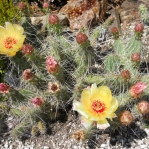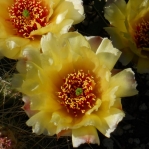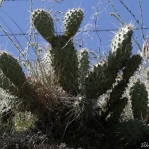
Griffiths, Bulletin of the Torrey Botanical Club 43: 523, 1916
Lectotype; Lectotype; Herbarium; Herbarium; Herbarium; Herbarium
Original Description
What is Opuntia columbiana?
Opuntia columbiana is a small prickly pear cactus that occurs in eastern Oregon, eastern Washington, and perhaps in lower British Columbia, Canada.
Details
There are conflicting descriptions of this plant. The lectotypes show plants with elongate or shorter, ellipsoid or obovate, pads.
One description reports that plants form low mats with cladodes that are flattened, narrowly to broadly obovate, and fragile. Second-year growth may be yellowish-green. Major spines are present in most areoles, reflexed to porrect and yellowish to gray-white to brown, (15)25-40(50) mm long. Radial spines are also present. The flowers are yellow, 30-50 cm across. Filaments are red or brownish-red and anthers are yellow. The style is white and the stigma is green. Fruits are seldom set. Seeds are tan and 5-7 mm across. The protruding girdle is 1-1.5 mm.
O. columbiana is reported to be hexaploid (but see below, perhaps differing taxa are represented by O. columbiana).
Other Notes
O. columbiana is referred to as O. × columbiana by some botanists (e.g., Anderson, 2001) who maintain that this Opuntia is a prickly pear hybrid between O. polyacantha erinacea and O. fragilis, and that it does not represent a stable, self-reproducing taxon.
More study is needed to resolve the conflicting information about this taxon. Possibly the plants referred to here represent two or more taxa.
The photos shown here may be O. columbiana.
O. columbiana is a small, hardy, cheerful garden plant.



